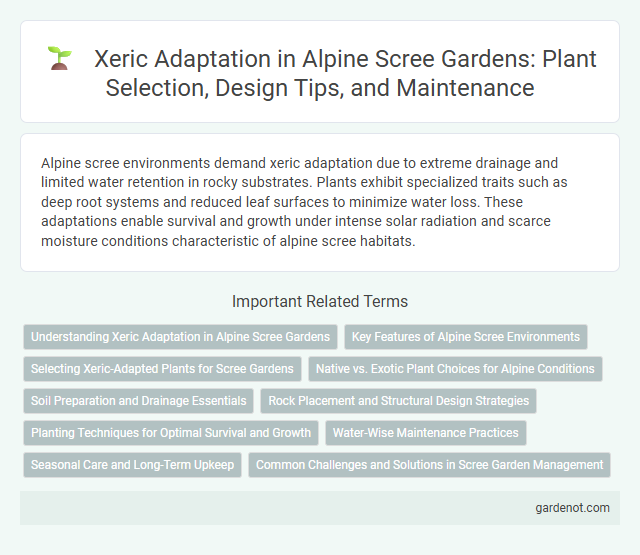Alpine scree environments demand xeric adaptation due to extreme drainage and limited water retention in rocky substrates. Plants exhibit specialized traits such as deep root systems and reduced leaf surfaces to minimize water loss. These adaptations enable survival and growth under intense solar radiation and scarce moisture conditions characteristic of alpine scree habitats.
Understanding Xeric Adaptation in Alpine Scree Gardens
Alpine scree gardens exhibit xeric adaptation through specialized root systems and reduced leaf surface areas, enabling plants to efficiently retain water in harsh, arid conditions. These adaptations include deep rooting and succulent foliage, which minimize water loss and maximize moisture absorption from rocky substrates. Understanding these traits reveals how alpine flora survive extreme moisture scarcity while maintaining metabolic functions.
Key Features of Alpine Scree Environments
Alpine scree environments exhibit extreme xeric adaptations characterized by minimal soil moisture, high exposure to wind, and intense solar radiation. These conditions lead to specialized vegetation with deep root systems, drought-resistant leaves, and rapid water absorption capabilities. The rocky substrate and limited organic matter further emphasize the importance of water conservation and efficient nutrient uptake for plant survival.
Selecting Xeric-Adapted Plants for Scree Gardens
Xeric adaptation in alpine scree involves selecting plants with specialized traits such as deep root systems, drought tolerance, and succulent foliage to thrive in well-drained, nutrient-poor substrates. Drought-resistant species like Sedum, Sempervivum, and dry-tolerant alpine grasses optimize water retention and minimize evapotranspiration in scree gardens. Incorporating native xerophytic plants enhances ecological stability and aesthetic value while ensuring resilience against harsh alpine microclimates.
Native vs. Exotic Plant Choices for Alpine Conditions
Native alpine plants exhibit superior xeric adaptations such as deep root systems and waxy cuticles, enabling efficient water retention in harsh scree environments. Exotic species often lack these specialized traits, leading to poor survival and potential disruption of local soil stability and nutrient cycles. Selecting native plants supports biodiversity and ecosystem resilience in alpine scree habitats.
Soil Preparation and Drainage Essentials
Alpine scree environments demand specialized soil preparation techniques to enhance water retention and nutrient availability, critical for xeric plant adaptation. Ensuring proper drainage through the incorporation of coarse gravel and sand prevents waterlogging while facilitating aeration essential for root health. Effective soil preparation balances moisture conservation with rapid drainage, promoting resilience in drought-tolerant alpine flora.
Rock Placement and Structural Design Strategies
Alpine scree environments exhibit xeric adaptation through strategic rock placement that maximizes water runoff capture and minimizes soil erosion, enhancing moisture retention in dry conditions. Structural design strategies involve angular rock fragmentation and interlocking formations that create microhabitats with reduced wind exposure and stabilized thermal regimes. These adaptations support specialized vegetation by maintaining essential moisture levels despite the arid, high-altitude terrain.
Planting Techniques for Optimal Survival and Growth
Alpine scree environments require xeric adaptations such as deep-rooted, drought-resistant plants that conserve moisture efficiently. Planting techniques emphasize well-drained substrate preparation, incorporating coarse gravel or sand to mimic natural scree conditions and prevent water retention. Strategic spacing and mulching with inorganic materials reduce soil evaporation, enhancing root establishment and overall plant resilience.
Water-Wise Maintenance Practices
Alpine scree plants exhibit xeric adaptations that enable survival in well-drained, nutrient-poor substrates by minimizing water loss and maximizing moisture absorption. Implementing water-wise maintenance practices such as drip irrigation, mulching with gravel, and scheduling watering during early morning hours reduces evaporation and ensures efficient water use. These strategies sustain healthy growth while conserving valuable water resources in alpine scree environments.
Seasonal Care and Long-Term Upkeep
Alpine scree plants exhibit xeric adaptations that enable survival in drought-prone environments by minimizing water loss through specialized leaf structures and deep root systems. Seasonal care involves targeted irrigation during prolonged dry spells and mulching with gravel to maintain soil moisture and reduce erosion. Long-term upkeep requires monitoring soil drainage and preventing nutrient depletion to support the plants' resilience in harsh alpine conditions.
Common Challenges and Solutions in Scree Garden Management
Xeric adaptation in alpine scree involves managing extreme moisture scarcity and temperature fluctuations that challenge plant survival. Common solutions include selecting drought-resistant species with deep root systems and using well-draining substrates to prevent waterlogging. Implementing microhabitat modifications like rock placement enhances moisture retention and shelter against wind stress.
Xeric adaptation Infographic

 gardenot.com
gardenot.com